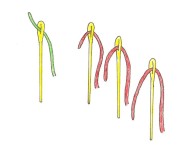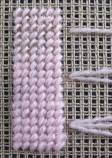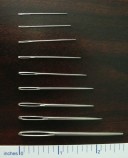Creating Good Canvas Coverage
When stitching, take time to check and determine if your thread is properly twisted. If not, you will get knots or weak spots.
The heavy sizing required to make canvas stiff is hard on the fibers. Each time you pass the needle through the mesh, the thread wears out just a little. For heirloom-quality embroidery, fold the yarn about 1½” from the end in the needle’s eye, and stitch. By using this method, you avoid the fiber from wearing out. Your canvas will be properly covered.
On the right, you will see red thread in three needles. Do not slide the thread on the needle as you stitch. You are creating thin spots in the thread. This is most important when you are working with wools, fuzzy threads or leathers. As the needle is passing through the canvas, the thread is wearing thin. It is best to stitch with the thread at the end of the thread such as the green example.
Never use a very long length of thread when stitching. A good rule is to use about 18" of wool yarn or cotton thread in your needle. If you are working with rayon or silk, use a shorter length.
Another problem could be your threads may not have the correct strands in the needle for the canvas size.
Always work with the correct size needle to fit your canvas and yarn. If the needle is too small for the canvas and thread, the fibers will wear thin. If the needle is too large, holes and distortion will result in your work.
See page Needle Chart








